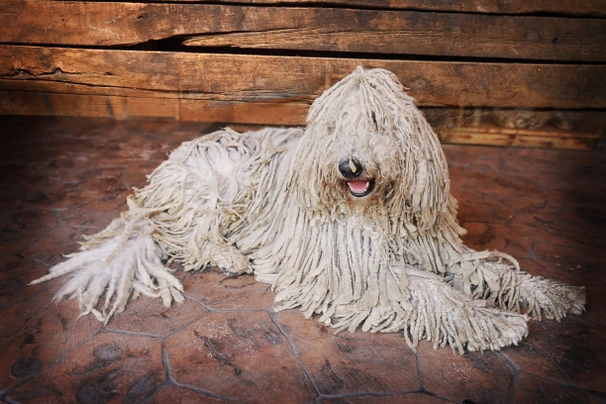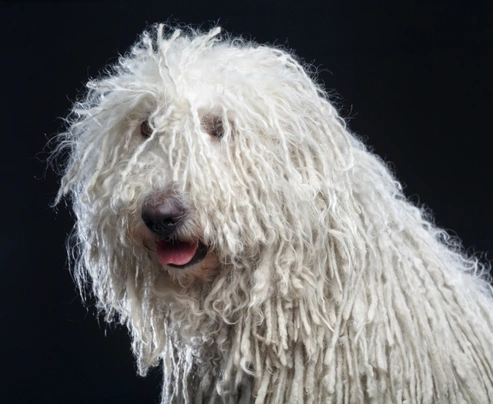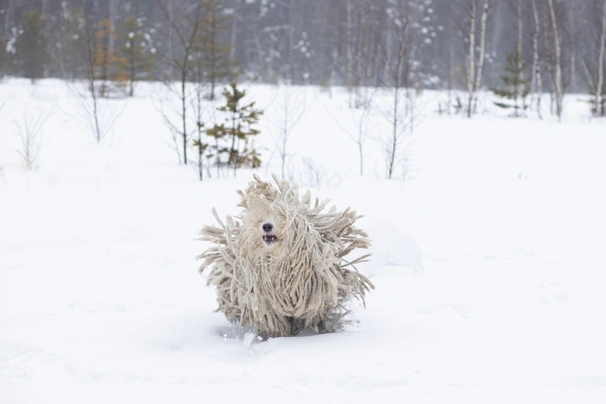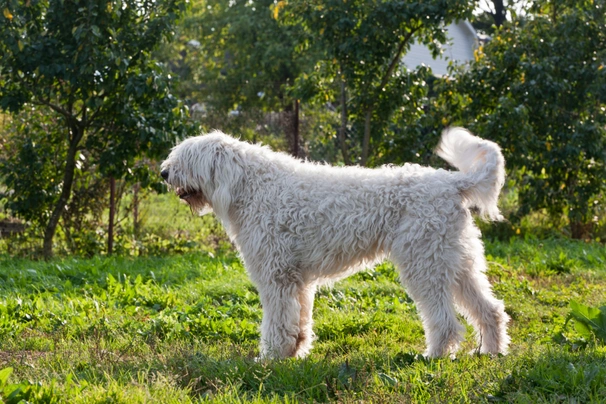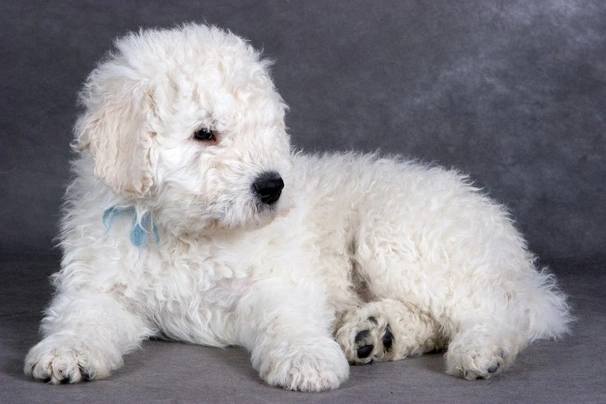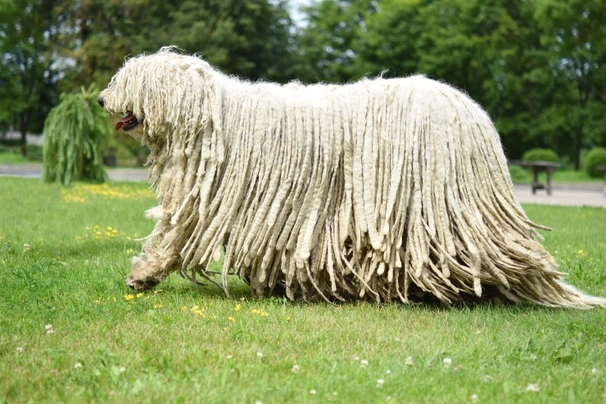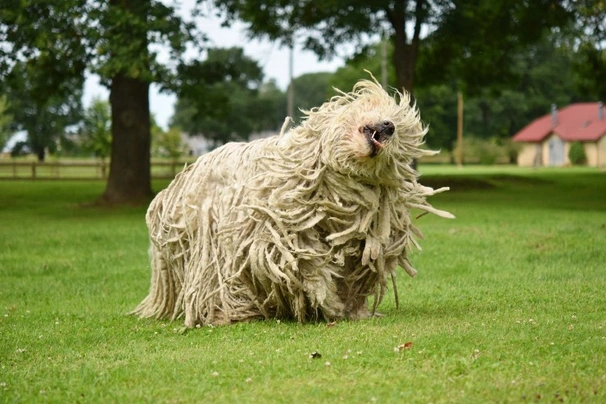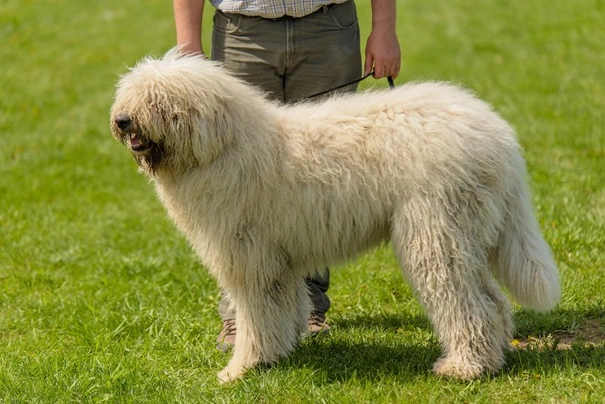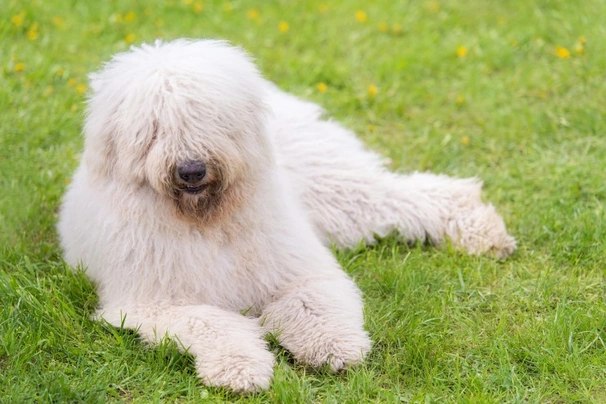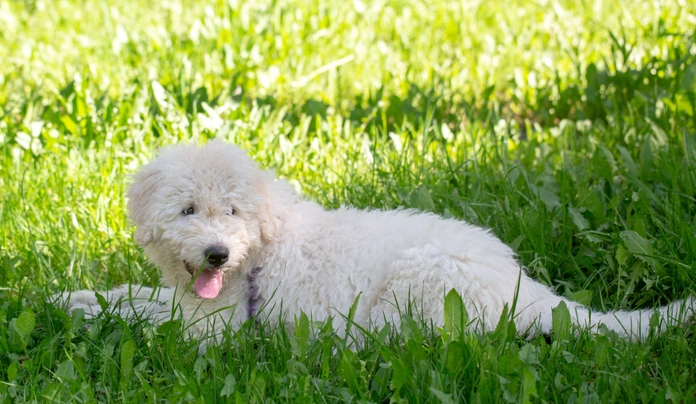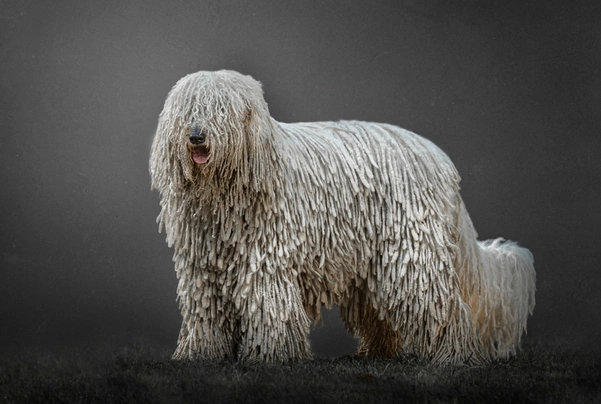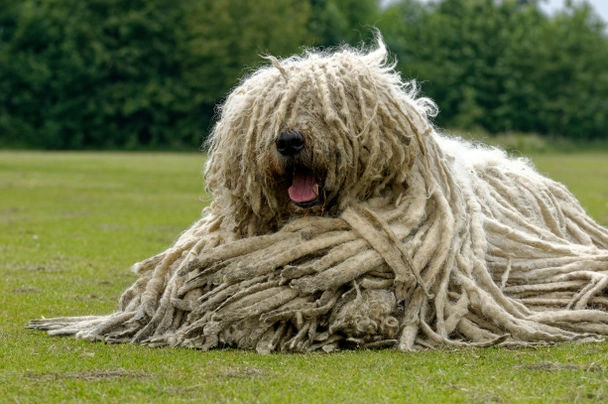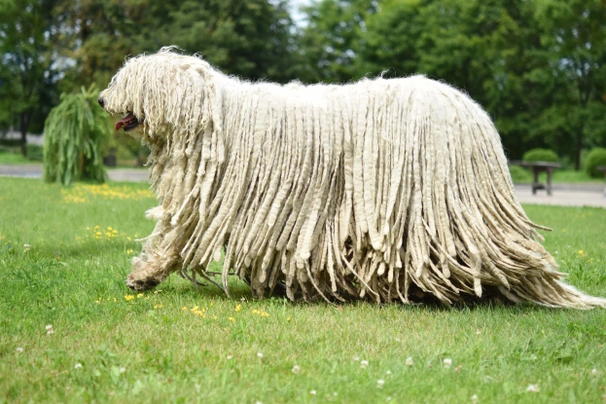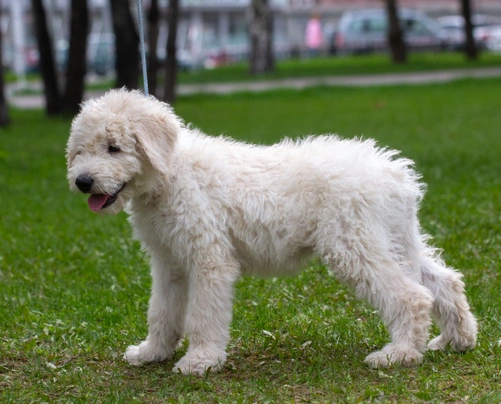Komondor
Pros
Cons
Introduction of the Komondor
The Komondor hails from Hungary where they have always been highly prized as working dogs. They are the largest of all Hungary's herding breeds and are best suited to living in a rural environment with people who lead active outdoor lives and who would like an alert loyal and courageous canine companion at their side. They are wonderful watchdogs and thrive in a home environment never being happy when left on their own which can lead to a Komondor suffering from separation anxiety.
The Komondor boasts having a striking white corded coat and although they do not need brushing their coats still need quite a bit of maintenance to keep them looking good. Although popular in their native Hungary and other European countries as well as in the showring finding well-bred KC registered Komondor puppies in the UK can prove challenging with waiting lists being long and puppies commanding a lot of money.
History of the Komondor
The Komondor is an ancient breed that was developed in Hungary to guard and protect large flocks of Racka sheep against wolves and other predators. It is thought that the breed’s ancestors were bought over to Europe by both the Magyar and Cuman tribes back in ancient times which is how they came to be known as the Koman-Dog. It is also thought that Komondors share a similar ancestry to that of the Russian Ovcharka although the dogs we see today are very different both in looks and character. The earliest record of the breed can be found in the 16th century but it's widely thought these dogs were around long before that when they were used to guard flocks of livestock.
Komondors were bred to have long corded coats to protect them from wolves and other predators that attacked the flocks they were protecting. Their thick long coats also offered a dog lots of protection from the harsh elements and were a brilliant camouflage for Komondors to hide amongst the sheep they were protecting. Having an element of surprise gave dogs a huge advantage over predators and thick long coats protected them from receiving painful and fatal bites. They were bred to be tough courageous and independent thinkers capable of working in some of the most challenging conditions and over harsh terrains.
Breed numbers fell dangerously low during the Second World War with many Komondors having been killed when Hungary was invaded in 1944. The reason being that invading soldiers find it virtually impossible to sneak past a flock of sheep without being attacked by the dogs that were protecting them. As such many farm dogs were killed during this time. On top of this many Komondors were used as guard dogs on military bases which meant they were often in the first line of fire from an invading army.
It is thought that fewer than 20 or 30 Komondors remained alive at the end of the war with most dogs being found in the more rural and remote farms in Hungary. Thanks to the efforts and dedication to saving the breed enthusiasts saved the Komondor from vanishing altogether and over the following years breed numbers once again began to rise albeit slowly.
However the breed remained an unknown outside of their native Hungary because of the “Iron Curtain” and the fact that no dogs could be exported. With this said some people managed to take a few Komondors over to America during the 1940’s because they recognised the breed. A breeding programme was established over the ensuing years and by the 1960’s Komondors were not only being bred as show dogs but also for their guarding abilities too.
Today the breed is still used to guard and protect flocks of sheep in Hungary but they are also used as working dogs in America too. With this said Komondors are still a rare breed with quite a small gene pool. It is also worth noting that many “show dogs” maintain a 5-generation pedigree much like their working counterparts.
Because so few Komondor puppies are bred every year anyone wishing to share a home with one of these striking looking dogs would need to register their interest with breeders and agree to being put on a waiting list because very few puppies are bred and registered with The Kennel Club every year.
Interesting facts about the breed
- Is the Komondor a vulnerable breed? Yes the breed is quite rare and not often seen in the UK apart from in the showring
- The Komondor was originally bred in Hungary by the Magyar people
- Komondors can be dominant making them a challenge to live with more especially when they are going through their adolescence
- They can often challenge a command when their training has not started early enough
- Komondors are never happier than when they are out at night controlling a garden’s boundary fence and if they are kept inside it can often lead to a dog barking and howling incessantly to go out
- The length of a mature Komondor’s coat often almost reaches down to the ground
- Their long white coats offered Komondors fantastic camouflage as it allowed dogs to hide among the large flocks of sheep they protected
- The Komondor has the heaviest of all coats in the dog world and it can take anything up to 8 years for a dog to grow their full adult coat
Appearance of the Komondor
Height at the withers: Males 65 80 cm Females 60 - 70 cm
Average weight: Males 50 - 61 kg Females 36 - 50 kg
The Komondor is a powerful looking dog and one that has an imposing presence. Their whole bodies are covered in masses of long white cords and their heads are quite big in relation to the rest of a dog's body being shorter than they are wide. They have a moderate stop and black noses with wide nostrils. However some Komondors have dark brown or dark grey coloured noses which is acceptable under their UK breed standard.
They have medium sized dark eyes with closely fitting rims and their ears are medium in size hanging down by a dog's head forming a U-shape. The Komondor has a strong jaw with a perfect scissor bite where their upper teeth neatly overlap their lower ones. Their necks are strong and moderately long being slightly arched showing no dewlap. Their shoulders are nicely laid back with dogs having straight well boned front legs.
The Komondor boasts having a deep and broad well-muscled chest and nice level back. Their rumps are broad but gently slope to the tail. Their bodies are slightly longer than tall at the withers and Komondors have nicely tucked up bellies. Their back legs show a good amount of bone being well muscled and their feet are large compact and strong with well arched toes and strong nails. The toes on a dog's back feet are slightly longer than their front ones. Tails are in line with a dog's rump which dogs carry curved at the tip but when excited they hold them out straight level with their bodies.
When it comes to their coat the Komondor boasts having a long harsh top coat which can be curly or wavy and a much softer undercoat. As the hair grows it forms long cords with the longest part being on a dog's rump loins and tails. The hair on a dog's back shoulders and chests is moderately long whereas on their cheeks around their eyes and mouths as well as on the lower parts of their legs it is a lot shorter. It is worth noting that a puppy’s coat is fluffy and soft and that they only start growing their adult coats when they are anything from 6 to 9 months old. To begin with a puppy’s coat has a buff or cream shading but this disappears with the hair turning white as they get older. The accepted breed colour for Kennel Club registration is as follows:
- White
It is worth noting that the accepted breed colours for Kennel Club registration can differ from those set out in the breed standard which are as follows:
- Always white and ideally a dog’s skin is grey but pink skin acceptable under the Kennel Club breed standard
Gait/movement
When a Komondor moves they do so with an easy light gait always taking very long strides and covering a lot of ground when they do.
Faults
The Kennel Club frowns on any exaggerations or departures from the breed standard and would judge the faults on how much they affect a dog's overall health and wellbeing as well as their ability to perform.
Males should have both testicles fully descended into their scrotums and it is worth noting that a dog can be a little lighter or heavier as well as slightly taller or shorter than set out in the Kennel Club breed standard which is only given as a guideline.
Temperament of the Komondor
Komondors are intelligent although they are independent by nature which when paired to the fact they can be strong willed means they are not a good choice for first time owners. Puppies take quite a long time to reach maturity which can be anything up to three years or longer. During their growing up they can be quite boisterous but once they reach maturity Komondors generally calm down. They form strong ties with their owners and as such become extremely protective of them which if not gently checked can develop into a real problem.
They are naturally wary of strangers which is a trait that's deeply embedded in a dog's psyche and why they have always been so highly prized as watch dogs. They can also be quite aggressive towards other dogs even when they have been well socialised as puppies. With this said it's really important for these dogs to be well socialised from a young age so they grow up to be well rounded dogs.
Their socialisation has to include introducing them to lots of new situations noises people other animals and dogs once they have been fully vaccinated. It's also crucial for their training to start early and it has to be consistent throughout a dog's life so they understand what is expected of them. A Komondor is never happier than when they know their place in the pack and who they can look to for direction and guidance. If they don't know who the alpha dog is in a household they may quickly take on the role of dominant dog which can make them harder to live with and handle. Komondors need to be handled with a firm fair and gentle hand right from the word go and puppies need to be taught the "basics and boundaries" as soon as they arrive in their new homes bearing in mind that Komondor will regularly tests limits throughout their lives.
Are they a good choice for first time owners?
Komondors are not the best choice for novice dog owners because they need to be socialised handled and trained by people who are familiar with their specific needs. Being so intelligent and independent thinkers by nature a Komondor could get the better of a first -ime dog owner making them harder to handle and live with.
What about prey drive?
Komondors have a high prey drive and will happily give chase to anything that moves or anything they perceive as being a threat to their family or their home. As such care must always be taken as to where and when a dog can run off the lead more especially if there is wildlife or livestock close by.
What about playfulness?
Komondors have a very playful side to their natures especially when young when playtime can be boisterous. being so clever they quickly learn how to please an owner which makes them great fun to be around. As dogs mature they take a more serious approach to life which sees Komondors doing what they do best which is to watch over and protect their families.
What about adaptability?
Komondors are better suited to households with large secure well-fenced back gardens that a dog can safely roam in whenever possible. As such they would not be the best choice for anyone living in an apartment.
What about separation anxiety?
Komondors form strong ties with their families and dogs are never very happy when they find themselves left on their own for long periods of time. They are better suited to people who either work from home or in households where one person stays at home when everyone else is out so they are never alone for any length of time which could see a dog suffering from separation anxiety. This can lead to them being destructive around the home which is a dog's way of relieving any stress they are feeling and a way to keep themselves entertained.
What about excessive barking?
Komondors like the sound of their own voices especially at night when they think it’s their job to watch over and protect their families and their property. Barking as a warning to strangers and anything they perceive as a threat is a trait that is deeply embedded in their psyche and therefore it’s something that is hard to correct in a Komondor not matter how firm yet gentle an owner is when dogs are still young.
Do Komondors like water?
Most Komondors love swimming and will take to the water whenever they can more especially when the weather is hot. However if anyone who owns a dog that does not like water should never force them to go in because it would just end up scaring them. With this said care should always be taken when walking a dog off the lead anywhere near more dangerous watercourses just in case a dog decides to leap in and then needs rescuing because they cannot get out of the water on their own. It is also important to thoroughly dry off a dog’s coat to prevent moisture from being trapped in it which could lead to a skin allergy flare-up.
Are Komondors good watchdogs?
Komondors are natural watchdogs which as previously mentioned is a trait that is deeply embedded in their psyche having been bred to protect and watch over flocks for centuries. As such even in a home environment it comes naturally for a Komondor to keep an eye on their surroundings and to let an owner know when there is something they don’t like going on or when there are strangers about. They have a wonderfully deep booming bark which would quickly put any wrong doers off coming onto a property.
Intelligence / Trainability of the Komondor
Komondors are smart dogs and when their training starts early enough in the right hands and environment they are easy to train. They can be strong willed and stubborn which is why they are best suited to owners who are familiar with the particular needs of this type of guarding dog. As such they are not the best choice for first time owners who might find it too challenging to train them.
The key to successfully training a Komondor is to make their training as interesting as possible and to avoid too much repetition. It's also a good idea to keep training sessions shorter which helps dogs stay focussed on what it’s being asked of them bearing in mind that the more intelligent a dog is the faster they get bored and Komondors are very smart dogs. They do not answer well to harsh correction or any sort of heavy handed training methods but they do respond extremely well to positive reinforcement which always brings the best out of these intelligent and quick-witted dogs especially when there are high value rewards involved.
Like all puppies Komondors are incredibly cute when young and it is all too easy to spoil them when they first arrive in new homes. As soon as a puppy is nicely settled owners must start out as they mean to go on by laying down ground rules and boundaries so that a puppy understands what is expected of them. It helps establish a pecking order and who the alpha dog is in the household. The first commands a puppy should be taught are as follows:
- Come
- Sit
- Stay
- Heel
- Quiet
- Leave it
- Down
- Bed
Children and other
The Komondor is best suited to households where the children are older and who therefore know how to behave around dogs. They can be a little "off" with children they don't already know which means care has to be taken when the kids have any friends over. With this said any interaction between younger children and a dog should always be well supervised by an adult to make sure everything stays calm.
Even when Komondors have been well socialised from a young enough age they are not good around other dogs so care has to be taken as to where and when they are allowed to run off their leads if other dogs are about. Care also has to be taken when they around smaller animals and pets which includes cats just to be safe. As such any contact is best avoided.
Health of the Komondor
The average life expectancy of a Komondor is between 10 and 12 years when properly cared for and fed an appropriate good quality diet to suit their ages.
The Komondor is known to suffer from a few hereditary health issues which are worth knowing about if you are planning share your home with one of these active and extraordinary looking dogs. The conditions that seem to affect the breed the most include the following:
- Hip dysplasia – dogs should be hip scored by a registered BVA vet or through the Animal Health Trust (AHT)
- Arthritis
- Ear problems
- Skin issues
- Bloat/gastric dilation
What about vaccinations?
Komondor puppies would have been given their initial vaccinations before being sold but it is up to their new owners to make sure they have their follow-up shots in a timely manner with the vaccination schedule for puppies being as follows:
- 10 -12 weeks old bearing in mind that a puppy would not have full protection straight away but would be fully protected 2 weeks after they have had their second vaccination
There has been a lot of discussion about the need for dogs to have boosters. As such it's best to talk to a vet before making a final decision on whether a dog should continue to have annual vaccinations which are known as boosters.
What about spaying and neutering?
A lot of vets these days recommend waiting until dogs are slightly older before spaying and neutering them which means they are more mature before undergoing the procedures. As such they advise neutering males and spaying females when they are between the ages of 6 to 9 months old and sometimes even when a dog is 12 months old.
Other vets recommend spaying and neutering dogs when they are 6 months old but never any earlier unless for medical reasons. With this said many breeds are different and it is always advisable to discuss things with a vet and then follow their advice on when a dog should be spayed or neutered.
What about obesity problems?
As with other breeds some Komondors gain weight after they have been spayed or neutered and it's important to keep an eye on a dog's waistline just in case they do. If a dog starts to put on weight it's important to adjust their daily calorie intake and to up the amount of exercise they are given. Older dogs too are more prone to gaining weight and again it's essential they be fed and exercised accordingly because obesity can shorten a dog's life by several years. The reason being that it puts a lot of extra strain on a dog's internal organs including the heart which could prove fatal.
What about allergies?
Komondors are prone to suffering from skin problems and allergies. As such it's important for a dog to see a vet sooner rather than later if one flares up. Allergies can be notoriously hard to clear up and finding the triggers can be challenging. With this said a vet would be able to make a dog with an allergy more comfortable while they try to find out the triggers which could include the following:
- Certain dog foods that contain high levels of grains and other cereal-type fillers
- Airborne pollens
- Dust mites
- Environment
- Flea and tick bites
- Chemicals found in everyday household cleaning products
Participating in health schemes
All responsible Komondor breeders would ensure that their stud dogs are tested for known hereditary and congenital health issues known to affect the breed by using the following schemes:
- Hip scored by a registered BVA vet or through the Animal Health Trust (AHT)
What about breed specific breeding restrictions?
Apart from the standard breeding restrictions that are in place for all Kennel Club registered breeds there are no other breed specific breeding restrictions in place for the Komondor.
What about Assured Breeder Requirements?
Apart from the standard breeder requirements for all Kennel Club registered breeds there are no other Assured Breeder requirements in place for the Komondor.
Caring for the Komondor
As with any other breed Komondors need to be groomed on a regular basis to make sure their coats and skin are kept in top condition. They also need to be given regular daily exercise to ensure they remain fit and healthy. On top of this dogs need to be fed good quality food that meets all their nutritional needs throughout their lives.
Caring for a Komondor puppy
Komondor puppies are boisterous and full of life which means it's essential for homes and gardens to be puppy-proofed well in advance of their arrival. A responsible breeder would have well socialised their puppies which always leads to more outgoing confident and friendly dogs right from the word go. With this said any puppy is going to feel vulnerable when they leave their mother and littermates which must be taken into account. The longer a puppy can remain with their mother the better although it should never be for too long either.
It's best to pick a puppy up when people are going to be around for the first week or so which is the time needed for a puppy to settle in. Puppy-proofing the home and garden means putting away any tools and other implements that a boisterous puppy might injure themselves on. Electric wires and cables must be put out of their reach because puppies love chewing on things. Toxic plants should be removed from flowerbeds and the home too.
Puppies need to sleep a lot to grow and develop as they should which means setting up a quiet area that's not too out of the way means they can retreat to it when they want to nap and it's important not to disturb them when they are sleeping. It's also a good idea to keep "playtime" nice and calm inside the house and to have a more active "playtime" outside in the garden which means puppies quickly learn to be less boisterous when they are inside.
The documentation a breeder provides for a puppy must have all the details of their worming date and the product used as well as the information relating to their microchip. It is essential for puppies to be wormed again keeping to a schedule which is as follows:
- Puppies should be wormed at 6 months old
- They need to be wormed again when they are 8 months old
- Puppies should be wormed when they are 10 months old
- They need to be wormed when they are 12 months old
Things you'll need for your puppy
There are certain items that new owners need to already have in the home prior to bringing a new puppy home. It's often a good idea to restrict how much space a puppy plays in more especially when you can't keep an eye on what they get up to bearing in mind that puppies are often quite boisterous which means investing in puppy gates or a large enough playpen that allows a puppy the room to express themselves while keeping them safe too. The items needed are therefore as follows:
- Good quality puppy or baby gates to fit on doors
- A good well-made playpen that's large enough for a puppy to play in so they can really express themselves as puppies like to do
- Lots of well-made toys which must include good quality chews suitable for puppies to gnaw on bearing in mind that a puppy will start teething anything from when they are 3 to 8 months old
- Good quality feed and water bowls which ideally should be ceramic rather than plastic or metal
- A grooming glove
- A slicker brush or soft bristle brush
- Dog specific toothpaste and a toothbrush
- Scissors with rounded ends
- Nail clippers
- Puppy shampoo and conditioner which must be specifically formulated for use on dogs
- A well-made dog collar or harness
- A couple of strong dog leads
- A well-made dog bed that's not too small or too big
- A well-made dog crate for use in the car and in the home that's large enough for a puppy to move around in
- Baby blankets to put in your puppy's crate and in their beds for when they want to nap or go to sleep at night
Keeping the noise down
All puppies are sensitive to noise including Komondor puppies. It's important to keep the noise levels down when a new puppy arrives in the home. TVs and music should not be played too loud which could end up stressing a small puppy out making them withdrawn timid and shy.
Keeping vet appointments
As previously mentioned Komondor puppies would have been given their first vaccinations by the breeders but they must have their follow up shots which is up to their new owners to organise. The vaccination schedule for puppies is as follows:
- 10 -12 weeks old bearing in mind that a puppy would not have full protection straight away but would only be fully protected 2 weeks after they have had their second vaccination
When it comes to boosters it's best to discuss these with a vet because there is a lot of debate about whether a dog really needs them after a certain time. However if a dog ever needed to go into kennels their vaccinations would need to be fully up to date.
What about older Komondors when they reach their senior years?
Older Komondors need lots of special care because as they reach their golden years they are more at risk of developing certain health concerns. Physically a dog's muzzle may start to go grey but there will be other noticeable changes too which includes the following:
- Coats become coarser
- A loss of muscle tone
- They can either become overweight or underweight
- They have reduced strength and stamina
- Older dogs have difficulty regulating their body temperature
- They often develop arthritis
- Immune systems do not work as efficiently as they once did which means dogs are more susceptible to infections
- Older dogs change mentally too which means their response time tends to be slower as such they develop the following:
- They respond less to external stimuli due to impaired vision or hearing
- They tend to be a little pickier about their food
- They have a lower pain threshold
- Become intolerant of any change
- Often an older dog can feel disorientated
Living with a Komondor in their golden years means taking on a few more responsibilities but these are easily managed and should include looking at their diet the amount of exercise they are given how often their dog beds need changing and keeping an eye on the condition of their teeth.
Older dogs need to be fed a good quality diet that meets their needs at this stage of their lives all the while keeping a close eye on a dog's weight. A rough feeding guide for older dogs is as follows bearing in mind they should be fed highly digestible food that does not contain any additives:
- Protein content should be anything from 14 – 21%
- Fat content should be less than 10%
- Fibre content should be less than 4%
- Calcium content should be 0.5 – 0.8%
- Phosphorous content should be 0.4 – 0.7%
- Sodium content should be 0.2 – 0.4%
Older dogs don't need the same amount of daily exercise as a younger dog but they still need the right amount of physical activity to maintain muscle tone and to prevent a dog from putting on too much weight. All dogs need access to fresh clean water and this is especially true of older dogs when they reach their golden years because they are more at risk of developing kidney disorders.
Grooming of the Komondor
Komondors boast having long cords that often reach right down to the ground. It takes quite a bit of time to keep their coats in good condition although they don’t need brushing. However it's important to keep an eye on a dog’s cords and to gently tease apart any that are too thick paying particular attention to the belly feet and a dog's back-end. It's also essential to remove any twigs or other debris that collects in their coat after a walk. The hair in a dog's ears also needs to be gently plucked when necessary. The hair around a dog's mouth also needs trimming which helps prevent food from getting stuck in it. The good news is that Komondors do not shed.
It's also important to get puppies used to having their paws touched so that when it comes to trimming their nails it's never a drama and to regularly check a dog’s ears and clean them when necessary. If too much wax is allowed to build up it can lead to a painful infection which can be hard to clear up. In short prevention is often easier than cure with ear infections.
Exercise of the Komondor
The Komondor is a high energy intelligent dog and as such they need to be given the right amount of vigorous daily exercise combined with lots of mental stimulation for them to be truly happy well-rounded dogs. They need a minimum of 60 minutes a day with as much off the lead time as possible but only in safe environments. If they are not given the right amount of mental stimulation and exercise every day a Komondor would quickly get bored and could even begin to show some destructive behaviours around the home which is their way of relieving any stress they are feeling and not necessarily because they are being naughty.
A shorter walk in the morning would be fine but a longer more interesting one in the afternoon is a must with as much off the lead time as possible. These dogs also like to be able to roam around a back garden so they can really let off steam. However the fencing has to be extremely secure to keep these active high-energy dogs in because if they find a weakness in the fence they will soon escape and could get into all sorts of trouble.
With this said Komondor puppies should not be over exercised because their joints and bones are still growing. This includes not letting a dog jump up and down from furniture or going up or down the stairs. Too much pressure placed on their joints and spines at an early age could result in a dog developing serious problems later in their lives.
Feeding of the Komondor
If you get a Komondor puppy from a breeder they would give you a feeding schedule and it's important to stick to the same routine feeding the same puppy food to avoid any tummy upsets. You can change a puppy's diet but this needs to be done very gradually always making sure they don't develop any digestive upsets and if they do it's best to put them back on their original diet and to discuss things with the vet before attempting to change it again.
Older dogs are not known to be fussy eaters but this does not mean they can be given a lower quality diet. It's best to feed a mature dog twice a day once in the morning and then again in the evening making sure it's good quality food that meets all their nutritional requirements. It's also important that dogs be given the right amount of exercise so they burn off any excess calories or they might gain too much weight which can lead to all sorts of health issues. Obesity can shorten a dog's life by several years so it's important to keep an eye on their waistline from the word go.
Because Komondors are known to suffer from bloat it is really important for them to be fed twice a day instead of giving a dog one larger meal a day. It's also a good idea to invest in a stand for their feed bowls which makes it easier for dogs to eat comfortably without having to stretch their necks down to reach their food. Dogs should never be exercised just before or just after they have eaten either because this puts them more at risk of suffering from gastric torsion.
Feeding guide for a Komondor puppy
Puppies need to be fed a highly nutritious good quality diet for them to develop and grow as they should. As a rough guide a Komondor puppy should be fed the following amounts every day making sure their meals are evenly spread out throughout the day and it's best to feed them 3 or 4 times a day:
- 2 months old - 294g to 339g depending on puppy's build
- 3 months old - 404g to 490g depending on puppy's build
- 4 months old - 456g to 544g depending on puppy's build
- 5 months old - 558g to 671g depending on puppy's build
- 6 months old - 649g to 779g depending on puppy's build
- 7 months old - 656g to 782g depending on puppy's build
- 8 months old - 655g to 782g depending on puppy's build
- 9 months old - 601g to 731g depending on puppy's build
- 10 months old - 558g to 728g depending on puppy's build
- 11 months old - 513g to 674g depending on puppy's build
- 12 months old - 474g to 621g depending on puppy's build
- 13 months old - 438g to 577g depending on puppy's build
- 14 months old - 435g to 536g depending on puppy's build
Once a puppy is 16 months old they can be fed adult dog food.
Feeding guide for an adult Komondor
Once fully mature an adult Komondor should be fed a good quality diet to ensure their continued good health. As a rough guide an adult dog can be fed the following amounts every day:
- Dogs weighing 36 kg can be fed 399g to 563g depending on activity
- Dogs weighing 50 kg can be fed 439g to 603g depending on activity
- Dogs weighing 61 kg can be fed 499g to 663g depending on activity
Komondor price
If you are looking to buy a Komondor you would need to register your interest with breeders and agree to being put on a waiting list because very few puppies are bred and registered with The Kennel Club every year. You would need to pay anything upwards of £1000 for a well-bred KC registered pedigree puppy.
The cost of insuring a male 3-year-old Komondor in northern England would be £24.67 a month for basic cover but for a lifetime policy this would set you back £85.38 a month (quote as of June2018). When insurance companies calculate a pet's premium they factor in several things which includes where you live in the UK a dog's age and whether they have been neutered or spayed among other things.
When it comes to food costs you need to buy the best quality food whether wet or dry making sure it suits the different stages of a dog’s life. This would set you back between £60 - £70 a month. On top of this you need to factor in veterinary costs if you want to share your home with a Komondor and this includes their initial vaccinations their annual boosters the cost of neutering or spaying a dog when the time is right and their yearly health checks all of which quickly adds up to over £1200 a year.
As a rough guide the average cost to keep and care for a Komondor would be between £90 to £160 a month depending on the level of insurance cover you opt to buy for your dog but this does not include the initial cost of buying a well-bred healthy Kennel Club registered Komondor puppy.
Buying advice
When visiting and buying any puppy or dog there are many important things to consider and questions to ask of the breeder/seller. You can read our generic puppy/dog advice here which includes making sure you see the puppy with its mother and to verify that the dog has been wormed and microchipped.
Finding well-bred Komondor puppies in the UK can be hard and waiting lists tend to be long which means that well-bred puppies command a lot of money. As such with Komondors there is specific advice questions and protocols to follow when buying a puppy which are as follows:
- Beware of online scams and how to avoid them. You may see online and other adverts by scammers showing images of beautiful Komondorpuppies for sale at very low prices. However the sellers ask buyers for money up front before agreeing to deliver a puppy to a new home. Potential buyers should never buy a puppy unseen and should never pay a deposit or any other money online to a seller. You should always visit the pet at the sellers home to confirm they are genuine and make a note of their address.
- As previously touched upon finding well-bred KC registered Komondor puppies can prove challenging in the UK. As such some amateur breeders/people breed from a dam far too often so they can make a quick profit without caring for the welfare of the puppies their dam or the breed in general. Under Kennel Club rules a dam can only produce 4 litters and she must be between a certain age to do so. Anyone wishing to buy a Komondor puppy should think very carefully about who they purchase their puppy from and should always ask to see the relevant paperwork pertaining to a puppy's lineage their vaccinations and their microchipping.

